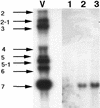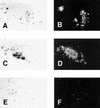Neuroinvasion by human respiratory coronaviruses
- PMID: 10982334
- PMCID: PMC102086
- DOI: 10.1128/jvi.74.19.8913-8921.2000
Neuroinvasion by human respiratory coronaviruses
Abstract
Human coronaviruses (HCoV) cause common colds but can also infect neural cell cultures. To provide definitive experimental evidence for the neurotropism and neuroinvasion of HCoV and its possible association with multiple sclerosis (MS), we have performed an extensive search and characterization of HCoV RNA in a large panel of human brain autopsy samples. Very stringent reverse transcription-PCR with two primer pairs for both viral strains (229E and OC43), combined with Southern hybridization, was performed on samples from 90 coded donors with various neurological diseases (39 with MS and 26 with other neurological diseases) or normal controls (25 patients). We report that 44% (40 of 90) of donors were positive for 229E and that 23% (21 of 90) were positive for OC43. A statistically significant higher prevalence of OC43 in MS patients (35.9%; 14 of 39) than in controls (13.7%; 7 of 51) was observed. Sequencing of nucleocapsid protein (N) gene amplicons revealed point mutations in OC43, some consistently found in three MS patient brains and one normal control but never observed in laboratory viruses. In situ hybridization confirmed the presence of viral RNA in brain parenchyma, outside blood vessels. The presence of HCoV in human brains is consistent with neuroinvasion by these respiratory pathogens. Further studies are needed to distinguish between opportunistic and disease-associated viral presence in human brains.
Figures


References
-
- Andersen O, Lygner P E, Bergstrom T, Andersson M, Vahlne A. Viral infections trigger multiple sclerosis relapses: a prospective seroepidemiological study. J Neurol. 1993;240:417–422. - PubMed
-
- Angerer L M, Angerer R C. In situ hybridization to cellular RNA with radiolabelled RNA probes. In: Wilkinson D G, editor. In situ hybridization, a practical approach. New York, N.Y: IRL Press; 1992. pp. 15–32.
Publication types
MeSH terms
LinkOut - more resources
Full Text Sources
Other Literature Sources
Medical

